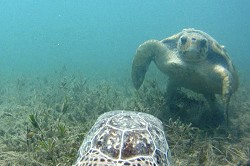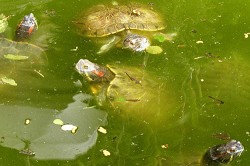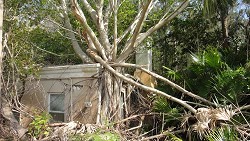 Juvenile blue striped grunts and black groupers sheltering in sponges and a sea rod in a seagrass bed. Photo taken by Sarah Manuel.
Juvenile blue striped grunts and black groupers sheltering in sponges and a sea rod in a seagrass bed. Photo taken by Sarah Manuel.
The Bermuda Platform consists of a variety of tropical marine habitats – coral reef, sandy bottoms, algal beds, mangroves and seagrass. These interconnected habitats are vital to fish, crustaceans, such as spiny lobsters, and sea turtles, in particular green turtles and hawksbills.
Since 2006 the Department of Conservation Services’ Marine Ecology Section has been monitoring the health of benthic habitats on the Bermuda Platform with a Benthic Mapping, Monitoring and Assessment Program . These programs were initiated in response to a reported decline in seagrass around Bermuda (Murdoch et al 2007). This decline may have significant effects on populations of green turtles, fish and crustaceans in Bermuda.
| Definitions: |
|---|
|
BENTHIC - relating to the bottom of the sea BENTHOS - the animals and plants living on |
 Green turtle in a bed of manatee grass (Syringodium filiforme). Photo taken by Kim Holzer.
Green turtle in a bed of manatee grass (Syringodium filiforme). Photo taken by Kim Holzer.
Green turtles in Bermuda waters have been protected by law since 1978 (Fisheries (Protected Species) Order 1978) and more recently seagrasses were added to Bermuda’s list of protected species (Protected Species Order 2012). We realize that a better understanding of the dynamic relationship between green turtles and their essential habitats in Bermuda is pivotal for developing a conservation strategy that protects both the turtles and their habitat.
In addition to our benthic monitoring program, we have conducted research addressing the effects of sea turtle grazing on the condition and health of seagrass in Bermuda. Initially, we placed exclusion cages to prevent turtles from feeding in three 2 m x 2 m plots in a heavily grazed seagrass meadow to determine if the seagrass under the cages would recover.
 Turtle exclusion cage 1 year after initiation of the experiment. Note the short seagrass leaves outside the turtle exclusion cage compared to the long, denser canopy of the seagrass (Thalassia testudinum) inside the cage. Photo taken by James Fourqurean.
Turtle exclusion cage 1 year after initiation of the experiment. Note the short seagrass leaves outside the turtle exclusion cage compared to the long, denser canopy of the seagrass (Thalassia testudinum) inside the cage. Photo taken by James Fourqurean.
After one year the seagrass leaves were as long as those in the nearby ungrazed meadow, indicating that over the short term seagrass can recover from heavy grazing (Fourqurean et al 2010). This summer, four years after the exclusion cages were installed, we removed them and positioned video cameras underwater to observe if turtles would return to eat the grass in the plots that had been protected. Twelve days later, there was no evidence of turtle grazing in the previously caged plots but the video footage documented turtles grazing outside the formerly protected seagrass plots. Previous studies have suggested that green turtles prefer the new growth on grazed shoots (Bjorndal 1997) and it appears that turtles in Bermuda may too.
Turtle Feeding behind formerly protected seagrass plot from Conservation Services on Vimeo.
 Attaching a satellite tag and pop off tag with video camera and time depth recorder to “Chubby” a green turtle caught in a seagrass bed near Chub Head, Bermuda. The orange pop off tag releases from the turtle after 24 hours, floats to the surface and is retrieved using a VHF receiver. The satellite tag will track the location of the turtle for approximately 300 days. Photo taken by Virginia Fourqurean.
Attaching a satellite tag and pop off tag with video camera and time depth recorder to “Chubby” a green turtle caught in a seagrass bed near Chub Head, Bermuda. The orange pop off tag releases from the turtle after 24 hours, floats to the surface and is retrieved using a VHF receiver. The satellite tag will track the location of the turtle for approximately 300 days. Photo taken by Virginia Fourqurean.
This summer we also extended our studies to look at how green turtles are using the Bermuda Platform. To do this we have attached satellite tags to 3 green turtles (http://www.tourdeturtles.org/Bermuda/) at three locations on the Platform. We also deployed small video cameras and time-depth recorders on pop off tags temporarily attached to 13 large green turtles. The video footage will provide information about turtle behaviour, showing the various habitats the turtles are using and what they are eating. The time depth recorders will tell us how long the turtles are at the surface, under the water, and to what depths they are going. The dive and surface interval data in association with boat surveys that count turtles will be used to help us estimate the number of green turtles on the Bermuda Platform. This is part of a longer term study designed to estimate the carrying capacity of the Bermuda Platform for green turtles.
 Chubby’s dive profile for 20 hours after he was released. The diving activity was recorded by a time depth recorder attached to the pop off tag.
Chubby’s dive profile for 20 hours after he was released. The diving activity was recorded by a time depth recorder attached to the pop off tag.
Turtle encounters from Conservation Services on Vimeo.
In addition to studying where green turtles live and move about on the Bermuda Platform, we have been collecting small samples of skin and carapace from the animals. These samples will be analyzed for nitrogen and carbon stable isotopes to determine the turtles’ diet. We are interested in knowing whether the green turtles on the Bermuda Platform are primarily eating seagrass or if they are supplementing their diet with other food items like they do in Shark Bay, Australia (Burkholder et al 2011). In Shark Bay it appears that green turtles derive most of their energy from macroalgae and gelatinous macroplankton (e.g. ctenophores and cnidarians) rather than seagrass. Knowing the full scope of the turtles’ diet, their behaviour, density and utilization of the different habitats will provide valuable information that will be incorporated into management strategies for the conservation of green turtles and their essential resources in Bermuda.
These studies are a collaborative effort between;
Sarah Manuel, Kathy Coates, Anson Nash, Jan Locke, Katie Dilke and Sarah Gosling, Department of Conservation Services
Mark Outerbridge, Bermuda Zoological Society
Jim Fourqurean, Derek Burkholder and Mike Heithaus, Florida International University
Jud Kenworthy, NOAA (retired)
Anne and Peter Meylan, Bermuda Turtle Project
Robert Hardy, Florida Fish and Wildlife Conservation Commission
References:









